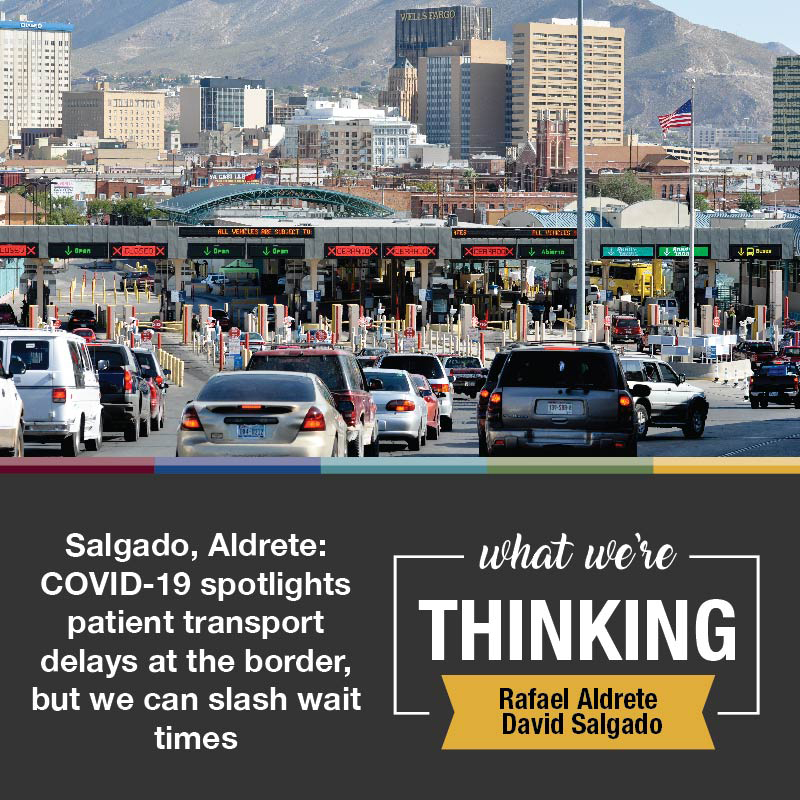 By David Salgado and Rafael Aldrete
By David Salgado and Rafael Aldrete
There aren’t many worse places to be than in the back of an ambulance. But being in the back of an ambulance in critical condition at a congested U.S.-Mexico border crossing is surely one of those places. Worse yet, being in a car instead of an ambulance – by choice – in the same dire shape.
The pandemic is exposing how border traffic gridlock can exacerbate life-threatening circumstances for COVID-19 patients. But higher mortality rates being tied to congested port-of-entry traffic is nothing new. The coronavirus is simply making a largely unnoticed dilemma a little more conspicuous. More than 300,000 American citizens currently live in Mexican border states, based on 2010 census figures. When any of them require insurance-backed emergency treatment at a U.S. hospital, their trip can include a border crossing wait time of more than 90 minutes. And no one knows that a Mexican ambulance with an American patient is on the way to the border until it arrives there.
Calls for ambulances to make that journey numbered more than 1,000 annually in recent years in the El Paso-Ciudad Juarez region alone, up from fewer than 200 calls in 2011. The number of actual patient transports, though, is likely even higher. That’s because private vehicles have often been used instead, likely due to the widespread misconception that a private vehicle will cross the border and reach a U.S. hospital more quickly than an ambulance. The fact that ambulances currently enjoy no official or formal preference that would expedite their crossing has not helped to dispel that flawed belief.
And that was all before the pandemic struck. As of late May, according to the Washington Post, about half of the coronavirus patients in California border region hospitals were American recent arrivals from Mexico.
Take a surge in COVID-19 patients and add them to the already growing numbers of stroke and heart attack victims seeking care north of the border, and you very quickly have a health care crisis compounded by an infrastructure failure, just waiting to happen.
But it doesn’t have to be that way. And a new process we’ve created to enhance ambulance operations at the border can ensure that it isn’t.
Currently, an unofficial process allows Mexican ambulances to use one southbound lane for northbound emergency medical transport. (Imagine the contraflow method of converting bi-directional freeway lanes to a single direction to facilitate evacuation from a coastal area under hurricane threat). But this practice is entirely informal, relying primarily on the good intentions and cooperation of U.S. and Mexico agency staffers, who change from one day to the next.
Our team at the Texas A&M Transportation Institute recently developed a system combining new traffic management and communication steps to formalize the now unofficial process and give ambulances a preference – and, more importantly, a reliable pathway – to avoid life-threatening delays on their way to American hospitals. A dedicated radio channel allows both nations’ customs officials to communicate and determine whether the ambulance should use an express lane for trusted travelers or the contraflow lane, which is cleared with the aid of changeable lighted message signs and signals. The new process facilitates passage to U.S. Customs inspection stations, where an American ambulance takes over patient transport to a U.S. hospital (since Mexican ambulances can’t legally operate here).
This new system can work without requiring any new construction or other physical changes to the border crossing facilities. So it’s not only a good idea; it’s also an inexpensive one. The enhanced process could also help increase public awareness and reduce the number of critical patients who try to cross in private vehicles, saving time and maintaining national security while improving patient outcomes.
Our tests show that using this new process can slash crossing times for critically ill patients by 80 percent or more, cutting a 90-minute delay to less than 15 minutes – more than enough to constitute a literal life-or-death difference.
Minutes matter, of course, especially in cases of strokes and heart attacks. Blockages in blood vessels are difficult enough on their own to survive. A blockage on a roadway at the same time could make survival impossible. And the same is true for those stricken by the coronavirus and its resulting respiratory trauma, known to worsen with alarming speed.
Our newest public health emergency is laying bare the often overlooked severity of a much older one. COVID-19 has given us a window of opportunity to alleviate both, by addressing the border traffic bottlenecks that constitute a major risk factor in any medical emergency.
David Salgado is an assistant research scientist at the Texas A&M Transportation Institute (TTI). Rafael Aldrete is a senior research scientist at TTI.
This article was originally published in Rio Grande Guardian, September 16, 2020.